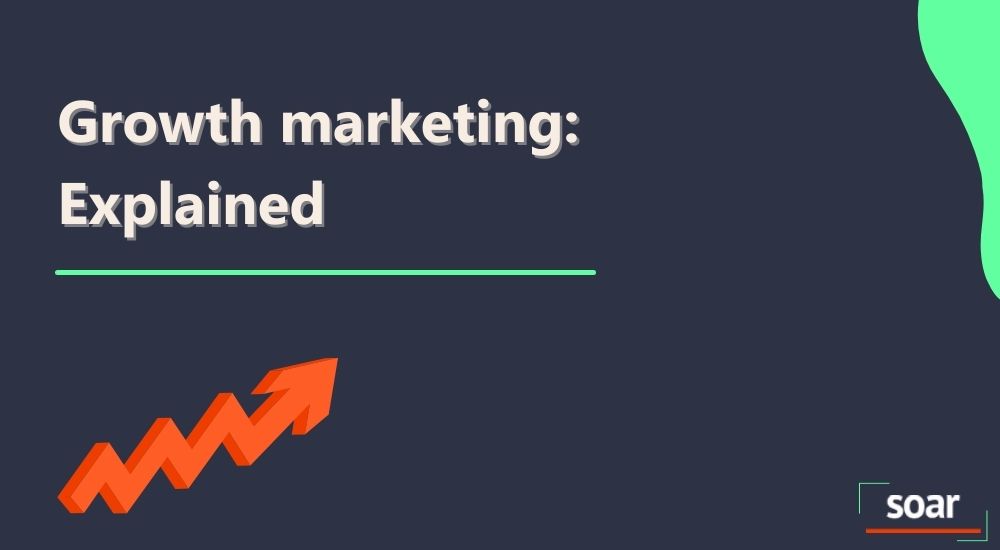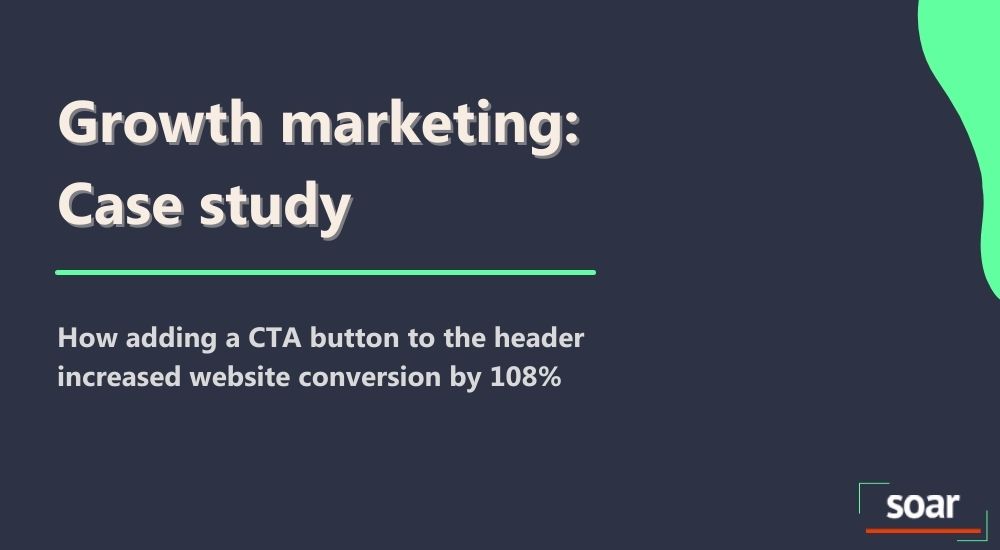Each year, about 627,000 new businesses start all over the US. Some grow fast and become forces to be reckoned with, leaving a huge impact on the world, while others remain small and eventually die out.
But how do the ones who do manage to grow at lightning speed, manage to create the impact they do just in a few years from setting up?
The answer to that is by leveraging the power of growth marketing, also commonly known as growth hacking.
So, if you’re a small business owner, looking to tap into the power of growth marketing, you have come to the right place. In this article, we are going to learn all about what is growth marketing and how a growth marketing funnel can help you grow your business effortlessly.

What is growth marketing?
Growth marketing is a powerful new technique of marketing that helps build a loyal user base to help business and marketing growth. It entails using data to drive marketing efforts to optimize demand generation for the business.
If asked for the growth marketing definition, in simple words it can be described as the process of designing growth marketing funnels and conducting experiments to improve the results of a target area. It is most effective when you have a certain metric you would like to improve.
Growth marketers create and use experiments to get unique insights about your customer’s motives and preferences and then use this data to attract, engage and retain your customers.
All the messaging that goes out to your customers is highly aligned and tailored to your customer needs and this helps with the growth of your business through a variety of channels. The responsibilities of growth marketing teams include:
- Identifying various problem areas to test and improve upon
- Designing highly targeted scientific experiments to optimize and improve the problem areas
- Conducting experiments to test hypothesized improvements and gather data
- Analyze data and conduct further experimentation as required
What makes growth marketing more effective than traditional marketing?
There is a reason why growth marketing is in high demand today, and that is because the growth marketing funnel goes beyond just the top layer.
When compared to traditional marketing that follows the ‘set it and forget it’ mindset, growth marketing comes up on top because it is always using data and insights to tweak its strategy for improved results.

To explain this further with an example, a traditional marketer would just set a budget and hope for the best, but a growth marketer would study the insights, conduct A/B testing, and constantly tweak the campaign, relying on scientific data to help them increase efficiency to guarantee success.
Now that we have understood the growth marketing definition and what makes it different from traditional marketing, let’s understand what are some of the core components of a powerful growth marketing strategy.
Core components of a powerful growth marketing strategy
Usually, every growth marketing funnel is based on a specific metric. It could be increasing conversion rate, customer lifetime value, customer acquisition rate, or customer retention rate.
No matter what the target metric though, a powerful growth marketing strategy has some core components that ensure success. They are as follows:
A/B testing
One of the best practices that the growth marketing funnel depends on is A/B testing or multivariate testing. These testing practices can be used for testing email campaigns, social media ads, landing pages, and various other digital campaigns.
For the A/B testing method, growth marketers use two different variations of content or design and run them to check what works better with the target audience. Data from the A/B testing will highlight what kind of design and content is more effective and you can use a similar format for all communication going forward to ensure better results and improve your performance with every test.

Another thing to remember while conducting your A/B testing is that just because one outcome proved to be more effective with a particular audience segment, that does not mean that it will have the same results with other audience segments.
So, make sure you conduct your A/B testing with customized audience groups so you understand what works best for that particular group.
Cross-channel marketing
This aspect of growth marketing is all about building an inclusive strategy across multiple channels to reach ideal customers. Some of the channels include email marketing, push notifications, direct mail, SMS messaging, in-app messages, and other relevant channels best suited to your target audience.

Building a cross-channel strategy helps you remain in touch with your audience, wherever they are, and help increase the effectiveness of your campaigns. You can also use A/B testing to check which platform is more effective with different segments of your target audience and keep that in mind while building your cross-channel strategy to increase effectiveness.
Customer lifecycle
If you’re wondering what a customer lifecycle means, it is basically the journey in which your customer learns about, interacts with, buys or converts, and re-engages with your company. For a growth marketer, this lifecycle of a customer is divided into three main stages – activation, nurture, and reactivation.

Growth marketers use specific campaigns at every stage of the customer lifecycle to engage and capture the interest of their customers. Let’s take a closer look at these three stages so you can understand what they are all about much better:
Activation stage
This is the first stage in the customer lifecycle wherein companies use different tactics to activate customer attention and interest. To do so, growth marketers target their customers with specific welcome offers, free trials, and other introductory offers to gauge the interest of their target audience.
Nurture stage
The second stage of the customer lifecycle is the nurture stage where the main aim of growth marketers is to engage consumers and strengthen existing relationships.
At this stage, growth marketers activate cross-channel marketing tactics to keep in touch with their customers. In this stage, brands send out emails, promotions, updates, newsletters, and more to keep their customers informed to nurture the existing relationship between them.
Reactivation stage
The final stage in the customer lifecycle is the reactivation stage. During this stage, growth marketers focus on re-engagement to drive customer retention and loyalty. Various tactics like post-purchase, loyalty programs, abandonment and win backs are used to re-attract the customer back to the brand.
All the three above mentioned stages are of equal importance for marketing growth as customers progress through these stages naturally at their own speed. It is the responsibility of the growth marketer to accommodate their changing needs and create campaigns for each of these changing needs.
Some examples of growth marketing campaigns
The best way to understand any new concept is through the right examples. So, to help you gauge what is growth marketing really, here are a few growth marketing campaigns in action. These are created to support a specific goal.

So, let’s dive in and understand each of them better:
Referral programs
According to data released by Nielson, 83% of customers are more likely to trust recommendations from friends and family over other more obvious sources of advertising. Hence, referral programs are some of the most powerful tools that are used by growth marketers for marketing growth and achieving better results.
Referral programs serve as powerful social proof of engaging new users and the goal of a growth marketer is to maximize the referral conversions per dollar spent. A lot of companies offer a two-sided referral program to incentivize both parties involved.
This means that both the user and the new referred user stand to benefit by using the referral link. Various brands like online bank Revolut, Trusted House Sitters, Dropbox and others utilize a strong referral program to increase signups and reduce the ad spend to acquire new users.
Onboarding
Every time a new customer signs up for your product or to your website, you have the opportunity to engage them further and get more data from them that will help you tailor future experiences for them.
But while it is important to get as much data as possible, you also need to make it easy and convenient for them to do so and also make sure that you do not overwhelm them in the process. The best way to do this is by creating a multi-channel onboarding sequence and trying to engage them with helpful and meaningful content.
You could start with a simple welcome message and then jump into asking them other important information like their preferences of products, their notification preferences, etc.
The data that you gather during the onboarding process will help you understand the user better and will help you optimize future offers to them for maximum engagement.
Top of the funnel engagement
While attracting new customers, it is important for marketers to understand that pushing too hard at the beginning can put them off and harm the brand’s reputation. In order to avoid this, brands need to focus on building a long-term relationship with both their existing customers and potential customers.
This is where growth marketers come in. They can help create a strong content marketing strategy based on thought leadership and use it to engage and entertain new customers who will be more likely to buy from the brand in the future.
Growth marketers start by understanding their target audience better and creating various buyer personas. This helps them gain more insights into their habits and preferences and allows them to get into their head and think like them. Using this, they are then able to create a content strategy designed to engage, educate and entertain each of them.
Growth marketers also use strong and clear call-to-actions to lead their target audience to the next level. Some call-to-actions include subscribing to newsletters, signing up for free offers, browsing the webshop, etc.
Loyalty
Building loyalty is important for every brand. This helps customer retention and ensures that all the customers you spent time and money acquiring keep coming back to you and choosing your products over those of your competitors.
Loyal customers are also very important because they tend to become spokespersons of your brand and are more likely to refer your brand to their friends and family. But how can brands build brand trust and gain those loyal customers? You can easily do so by showing them how valuable they are to you.
Growth marketers create loyalty campaigns in order to keep customers coming back for more. You can offer your loyal customers sneak peeks, exclusive access, free upgrades, and other benefits to show them how much you appreciate them. Creating the right loyalty program will help you create a loyal following of customers that every brand dreams of having.
Other growth marketing strategies to follow
It is important that growth marketers understand the customer journey, customer experience on the website and conversion rate optimization. I am not talking about having a degree within these topics but to understand the key metrics that are needed in order to grow and run experiments effectively.
Best growth marketers are also called growth hackers, as it seems like they are “hacking” their way to the top. Most growth marketers focus on acquisition marketing part of the funnel but it is important to keep improving the entire customer funnel.

Our growth marketing case study
At Soar, we started implementing growth marketing strategies in September 2021. We focused primarily on acquiring customers by using customer data and using different marketing channels. Our goal is to be seeing sustainable growth over the years, by running numerous experiments and trying different growth marketing tactics.
I guess you have already heard within hospitality industry that every customer is right and we should always do what they ask you to… Yeah well… Our approach is slightly different, yet better.
We work hard on understanding the customer journey, customer acquisition cost, customer engagement, customer satisfaction and more, to to retain customers. The reason is to become a growth marketing partner for you and create a close long term relationship instead of just being another agency.
How adding a CTA button to the header increased our conversion
We started running small growth experiments and analyzing the results. One of the first experiments we run was re-structuring the header navigation and adding a call to action (CTA) button for a better conversion.
Here is how the header navigation looked like before.

Here is how it looks like now on desktop.

Here is how it looks like now on mobile.

Not a huge difference right? But that small experiment ended up making a big difference in results. In the first month after the change, we achieved a 15% increase in the rate of people scheduling calls on mobile and 108% rate of people scheduling calls on desktop.
Boom!
Trust me, we were shocked even more than you are right now to see such a great results, by running fairly small experiment in a short period of time.
Conclusion
The goal of growth marketing is to test and run experiments, and keep increasing the number of experiments over time. The more experiments you run, the more you grow over time.
Stay tuned for more growth marketing experiments from us and fell free to reach out if you need a professional help to grow your brand.
Need help hacking your business growth and creating a strong and effective growth marketing strategy for your business? Schedule a free call with our growth marketing experts and let’s get the ball rolling.